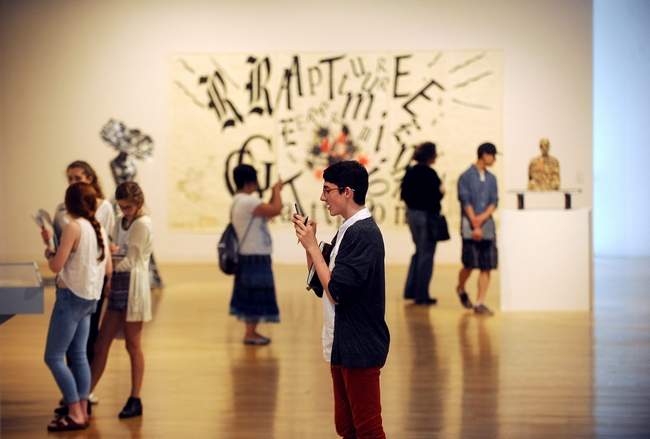By April M. Crehan via Westford – Wicked Local

Needham High School senior Tyler Villa takes a photo at the DeCordova Museum, where new exhibits are open for the summer, on Friday morning. Wicked Local Staff Photo/David Gordon
The old adage that a picture is worth a thousand words turns tangible in the summer exhibitions at deCordova Sculpture Park and Museum, where poetry pops off the page and into three dimensions.
Languages function as inspiration and shape in selected works from two featured artists as well as pieces from the deCordova’s permanent collection.
Sharing the Linde gallery space is a posthumous exhibit of poet Ian Hamilton Finlay’s work and that of multimedia artist Lesley Dill. The dual use of Linde gallery space is an experiment for deCordova staff, who in the past have focused the room on a single artist.
“Our shows are up for quite a long time and I feel like we were playing Russian roulette with our visitors,” said curator Jennifer Gross of the hit-or-miss risk with one-artist installations. “It’s to serve our audiences better.”
The concrete poetry of Finlay pairs seamlessly with Dill’s work, which takes the idea of lexical concreteness to a physical level in her constructions of forms out of wooden, bronze, foil and horsehair words. Her work draws heavily on the writing of Emily Dickinson thanks to a 40th birthday present of a volume of her poetry, explained Assistant Curator Lexi Lee Sullivan.
Other literary notables referenced in the artist’s work are Franz Kafka and Dill’s contemporary, Tom Sleigh. The current exhibit shows work from 1993 to 2012.
“This show really highlights all the different materials she works in,” Sullivan said. “For many of the bronzes, she sculpts them first as paper. For her, it also reads as a type of skin… It’s all about this touch and texture.”
A “word queen” — Dill’s phrase to describe her letter-draped regal dress form — reigns over the space and bridges the conceptual space between her most language-heavy work and the fractured figures (such as eyes with no face, hands with no arms) that feature prominently in the exhibition. A statue protruding from stairwell wall space and the outdoor bronze sculpture meld the exhibit into the landscape of the museum, as with the outdoor pieces that complete the Finlay exhibit.
Finlay, said Gross, was an agoraphobic poet who created his own world, Little Sparta (now a landscape architect Mecca) and interacted with other artists to create the concrete expressions of poetry. He was trying to reclaim what he saw as a corrupt culture, Gross explained.
“He felt that the only way to get our attention was to use military insignia,” she went on, pointing out classical Apollo forms holding modern weaponry and a sturdy-looking tortoise with the words “Panzer Leader” inscribed on it.
“Nature is not well-behaved. Nature itself is full of degradation and hostility and unhappy things,” Gross commented on Finlay’s intersecting warfare and the natural world.
A second gallery of Finlay’s work reveals the heavy influences of his seafaring father (a bootlegger until Prohibition ended) and French revolutionary philosophy. Gross, who described Finlay as allergic to the world, said that he was seeking not to lead a revolution himself, but to inspire one.
The exhibition includes Finlay’s lighter pieces, a set of postcards produced by his printing company and showcasing his wordplay and artistry.
Two PLATFORM installations are also part of the summer exhibits. The PLATFORM series features early and mid-career artists reacting to the deCordova site. Andrew Mowbray, the first PLATFORM artist, said the relationship between outdoor and indoor that he acknowledged in his work (the rooftop installation of a drawing machine) has continued to be a subtext for those featured.
“My work was spanning a few different ways of creating work: performance, video, photography… There were aspects of trying to get back to nature,” he said.
The same elements are visible in the two current installations: Roberley Bell’s vaguely Seussian rooftop garden and Alix Pearlstein’s video portrayal of the Sculpture Park’s grounds.
“It’s a great opportunity for artists,” said Mowbray, who sees the series as a platform for artists pushing the limits of their media. “I went into it really excited. There wasn’t as much pressure as something that didn’t have that experimental context behind it. It seemed open-ended in a way.”
The deCordova summer exhibits are open through early October. Admission is free for Lincoln residents.
